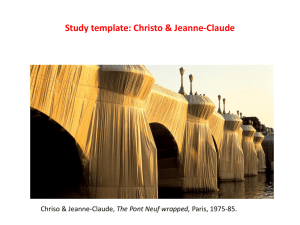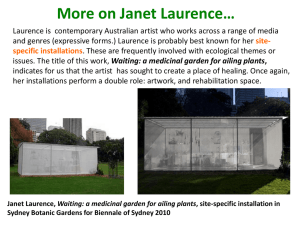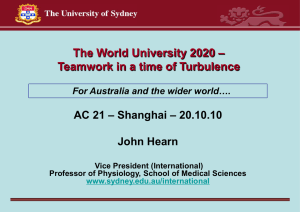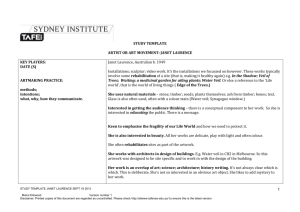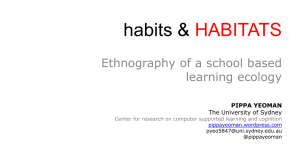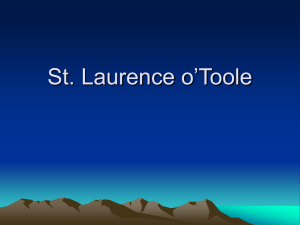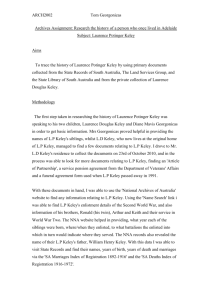HSC QUESTIONS + JANET LAURENCE 2
advertisement
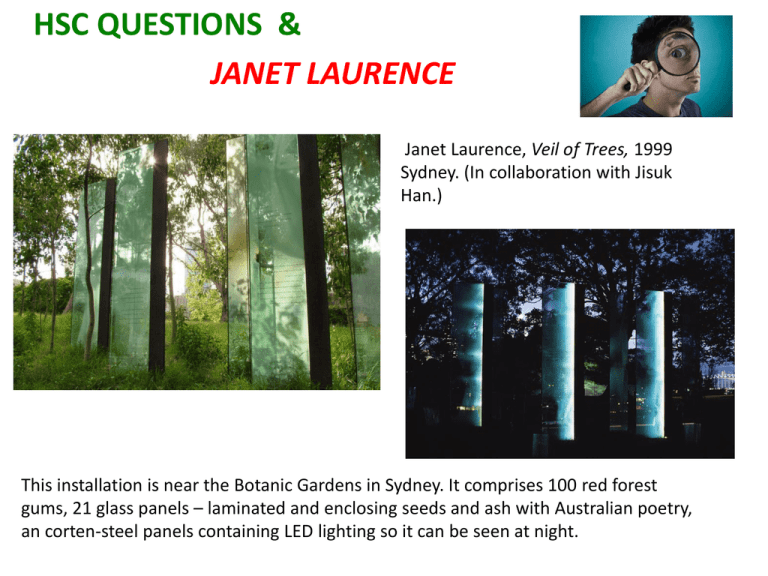
HSC QUESTIONS & JANET LAURENCE Janet Laurence, Veil of Trees, 1999 Sydney. (In collaboration with Jisuk Han.) This installation is near the Botanic Gardens in Sydney. It comprises 100 red forest gums, 21 glass panels – laminated and enclosing seeds and ash with Australian poetry, an corten-steel panels containing LED lighting so it can be seen at night. Section I of the exam has three short answer questions. They are worth increasing amounts of marks, depending on difficulty. This question is the easiest, it’s worth 5 marks and suggests allowing about 9 minutes to answer. Check out today’s handout to see precisely what the exam booklet looks like, and how the marks are worked out. Q: Apply the structural frame to describe techniques used in Plate 1. Plate 1: Sarah Fordham, (b . 1974, Australian) Pokeepskie, 2007, acrylic, oil and enamel paint on canvas, 120 x 90cm Q: Refer to Plates 2 & 3. Explain how these artworks reflect the world of artists. (Worth 8 marks – second hardest – suggest 15 minutes for this question.) Plate 2: Diego Velazquez (1599-1660, Spanish.) Las Meninas (The Ladies in Waiting,) 1656, Oil on canvas, 318 x 276cm. Plate 3: Tracey Moffatt (b. 1960, Australian.) First Jobs, Meat Packing 1978, 2008. Photograph. Archival pigments on rice paper with gel medium 71 x 91cm. Edition of 20. Janet Laurence Janet Laurence, b. 1949 Aust. In the shadow, site specific installation Homebush Bay, 2000 Janet Laurence is a contemporary artist who works across a wide range of media including painting, photography and sculpture. She is probably best known for her sitespecific installations such as In the shadow, an installation involving a 100 metre length of a creek at Homebush Bay in 2000. It was created especially for the Sydney Olympics. Unlike many installations, this one has become a permanent part of the landscape. Laurence wants to convey a message with her work. She is concerned with environmental issues, and all her work is involved with engaging an audience and getting them to reflect upon this. Many of her works act to rehabilitate an area or a group of plants, whilst being artworks as well; they therefore could be said to have a double function: they’re not just something for people to look at. It’s engaging with the world in a particular way, a more politically active way than say, Christo & Jeanne-Claude or Goldsworthy. In the shadow, 2000, details The idea of audiences interacting with artwork with their bodies is not new….where have we seen this before? Antony Gormley, (b. 1950, British) Asian Field, 2006, (180,000 terra cotta figurines in a warehouse at Sydney Biennale.) >>>>>> <<<<<Aerial view of Inside Australia,2002-3 Life-size bronze figures from Inside Australia, 20023 Lake Ballard Western Australia. There were 51 figures life sized vertically but squeezed horizontally, placed 750metres apart. They were based on the bodies of people from the local area. >>>>>>> Christo & Jeanne-Claude, Wrapped Coast 1969, Sydney. The huge scale of this work would have impacted on the audience…it was over a kilometre long. Walter De Maria (US, b. 1935): Lightning field, 1977, New Mexico. The impact of lightning, often accompanied by thunder would impact physically. Laurence is also interested in memories of places and peoples, and the concept of change. Edge of the Trees is an installation in collaboration with Australian artist Fiona Foley, in the forecourt of the Museum of Sydney (down near Circular Quay.) This consists of column structures of steel, sandstone, and timber. The work lists names of indigenous people from the Eora tribe from the early days of white settlement. They are engraved on sandstone pillars. The Sydney harbour area is made of sandstone, and was used from Colonial times as a construction material for buildings. Edge of the trees, 1995, sandstone, wood, steel, oxides, shells, honey, bones, zinc, glass, sound, 29 pillars Edge of the trees, detail. Coming from within the installation are a continuous sound recording of voices. They murmur quietly, you have to struggle to catch them. They are Koori place names… places which have, of course, been colonised. The voices sound like ghosts murmuring through the trees like a breeze. Timbers which grew on this site were used to build a foundry for the colony in Sydney. The timbers were salvaged from that building in the 1990s and ‘re-planted’ back at the Museum site for this installation. They were engraved with names of fruits and flowers from the Colonial Governor’s Garden, in Latin and in indigenous language. Steel columns are also included in the installation, designed to rust red into the sandy ground in which they are embedded. Names of First Fleet passengers are also included, engraved on zinc panels and fastened to the poles. The installation includes steel and glass structures as well, which contain material such as rock oxides, bone, shells and ash, which would have been from the indigenous campsites around the area. The structure is reminiscent of traditional Aboriginal burial poles. When a person dies, once the flesh is gone the bones are broken up and put into a decorated pole as the final part of the funeral ceremony. Edge of Trees, details. <<Aboriginal burial poles, Tiwi Island. Resources ‘A hospital for plants: the healing art of Janet Laurence’, in Art & Australia, Vol. 48 No. 1 2010, p.p. 64-67. Janet Laurence’s website: http://www.janetlaurence.com/ Museum of Contemporary Art Education Kit: http://www.mca.com.au/media/uploads/files/ITB_Education_ Kit_v3.pdf Sydney Olympic Park Public Art: http://www.sopa.nsw.gov.au/__data/assets/pdf_file/0010/47 5309/fact_sheet_COMMU_Public_Art02.pdf
